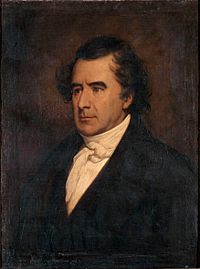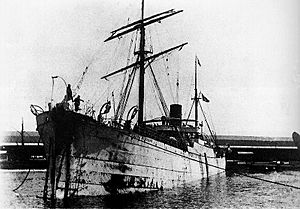François Arago facts for kids
Quick facts for kids
François Arago
|
|
|---|---|

Portrait by Charles de Steuben
|
|
| President of the Executive Commission | |
| In office 9 May 1848 – 28 June 1848 |
|
| Preceded by | Jacques-Charles Dupont de l'Eure (as President of the Provisional Government) |
| Succeeded by | Louis-Eugène Cavaignac (as Chief of the Executive Power) |
| Minister of War | |
| In office 5 April 1848 – 11 May 1848 |
|
| President | Jacques-Charles Dupont de l'Eure |
| Preceded by | Louis-Eugène Cavaignac |
| Succeeded by | Jean-Baptiste-Adolphe Charras |
| Minister of the Navy | |
| In office 24 February 1848 – 4 May 1848 |
|
| President | Jacques-Charles Dupont de l'Eure |
| Preceded by | Louis Napoléon Lannes |
| Succeeded by | Joseph Grégoire Casy |
| Personal details | |
| Born | 26 February 1786 Estagel, Roussillon, France |
| Died | 2 October 1853 (aged 67) Paris, Seine, France |
| Resting place | Père Lachaise Cemetery, Paris |
| Political party | Moderate Republican |
| Spouse |
Lucie Carrier-Besombes
(m. 1811; died 1829) |
| Children | Emmanuel Arago Alfred Gabriel |
| Alma mater | École Polytechnique |
| Profession | Astronomer, physicist, mathematician |
| Known for | Rotary polarization Polarizer Eddy currents Fresnel–Arago laws Arago spot Arago's rotations Arago telescope |
| Awards | Copley Medal |
| Scientific career | |
| Fields | Astronomy, mathematics, physics |
| Institutions | Bureau des Longitudes, French Academy of Sciences, Paris Observatory |
| Patrons | Siméon Denis Poisson Pierre-Simon Laplace |
| Influences | |
| Influenced | |
| Signature | |
 |
|
Dominique François Jean Arago (known as François Arago; 26 February 1786 – 2 October 1853) was a famous French mathematician, physicist, and astronomer. He was also a politician who worked to make France a better place.
Contents
Early Life and Education
François Arago was born in a small village called Estagel in France. His father worked as a treasurer. François was the oldest of four brothers. His brother Jean became a general in the Mexican army. Jacques Étienne Victor was an explorer and writer. Étienne Vincent was a playwright.
François loved military subjects. He went to college in Perpignan to study mathematics. He wanted to join the École Polytechnique in Paris. He learned very quickly and surprised his teachers with his knowledge.
In 1803, Arago joined the École Polytechnique. In 1804, he became a secretary at the Paris Observatory. There, he met famous scientists like Pierre-Simon Laplace.
Measuring the Earth
Arago was asked to help measure the meridian arc in Spain. This was a big project to find the exact length of a metre. He worked with another scientist, Jean-Baptiste Biot. They started their work in 1806.
After Biot left, Arago continued the measurements alone. He had to light fires on mountaintops to help with his measurements. But the local people thought he was a spy for the French army. They arrested him in June 1808.
Arago escaped from prison and tried to sail to France. But his ship was captured by Spanish pirates. He was imprisoned again in Spain. After three months, he was released and tried to sail home again. Strong winds blew his ship off course to Africa.
Finally, after many adventures and delays, Arago reached Marseille, France, in 1809. He had managed to keep all his important scientific notes safe.
Amazing Scientific Discoveries
Because of his brave work, Arago was chosen to join the French Academy of Sciences at just 23 years old. He also became a professor at the École Polytechnique. He lived at the Paris Observatory and gave popular lectures on astronomy.

Arago studied many things in physics. He researched the pressure of steam and the velocity of sound. He also made important discoveries about magnetism. He found that a spinning copper plate could make a magnet move. This is called "rotatory magnetism" or eddy currents. Michael Faraday later explained why this happens. For this work, Arago received the Copley Medal in 1825.
Arago was a big supporter of the wave theory of light. He worked with Augustin-Jean Fresnel to prove that light travels in waves. They did experiments on how light polarizes. Arago even invented the first polarizer in 1812. He also discovered the "Arago spot", a bright spot that appears in the shadow of a circular object when light shines on it. This helped prove the wave theory of light.
Arago also suggested a way to measure the speed of light in air and water. He believed light would slow down in denser materials, which supported the wave theory. His ideas were later used by other scientists to prove this.
Political Career and Legacy
In 1830, Arago became a member of the French parliament. He was a strong supporter of republican ideas. He used his position to help public education and support inventors. He helped get money for things like railways and electric telegraphs. He also played a role in getting Louis Daguerre recognized for inventing photography.
In the same year, Arago became the director of the Paris Observatory. He helped get money to improve the observatory and buy new instruments. He also became the permanent secretary of the Academy of Sciences. He wrote many important scientific articles and gave speeches about famous scientists.
In 1848, France had a revolution. Arago left his scientific work to join the new government. He became a minister, in charge of the navy and colonies, and also the minister of war. He made important changes, like improving food for sailors and ending flogging (a harsh punishment) in the navy.
Most importantly, Arago worked hard to end slavery in the French colonies. Despite many people being against it, he succeeded in getting slavery abolished.
He later became the President of the Executive Power Commission, acting as a temporary head of state. In 1852, when Napoléon III came to power, he asked all government workers to take an oath of loyalty. Arago refused because he was a strong republican. Napoleon III respected him so much that he allowed Arago to keep his job without taking the oath.
Cape Arago in Oregon, USA, is named after him.
Final Years
Arago remained a dedicated republican until the end of his life. He suffered from health problems like diabetes. In 1853, he traveled to the Pyrenees mountains, hoping the air would help him. But he passed away in Paris. He is buried in the famous Père Lachaise Cemetery in Paris.
Named after Arago
- The study association for Applied Physics at the University of Twente is named after Arago.
- His name is one of the 72 names inscribed on the Eiffel Tower.
- The asteroid 1005 Arago, an inner ring of Neptune, the lunar crater Arago and the Martian crater Arago were all named in his honor.
- Two French cable ships were named after him: the François Arago (1882) and the Arago (1914/1931).
Honours
 Kingdom of Belgium: Officer of the Order of Leopold.
Kingdom of Belgium: Officer of the Order of Leopold.- 1842 Prussian Pour le Mérite for Sciences and Arts.
See also
 In Spanish: François Arago para niños
In Spanish: François Arago para niños
- The works of Antonin Mercié
- History of the metre
- Seconds pendulum




